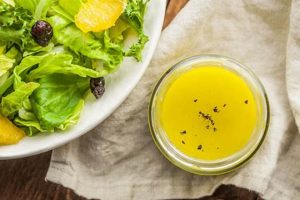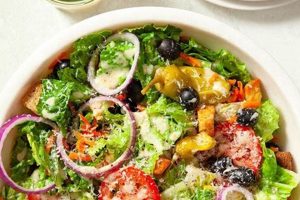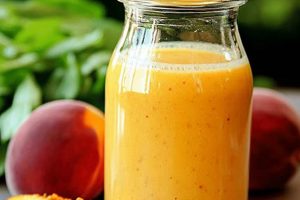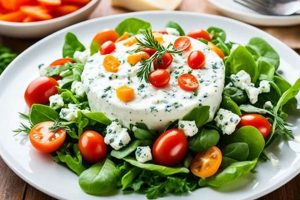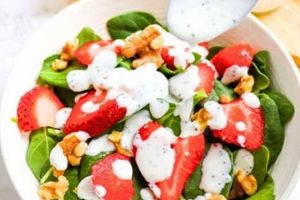Vinaigrettes and dressings made with yogurt, buttermilk, or pureed fruits and vegetables offer flavorful, lower-fat alternatives to traditional creamy dressings. For instance, a simple lemon vinaigrette comprises fresh lemon juice, olive oil, and herbs. Such options allow for customization, accommodating dietary restrictions and preferences while adding nutritional value.
Healthier dressings contribute significantly to overall well-being. They can reduce saturated fat and calorie intake, while boosting the consumption of beneficial fats, vitamins, and antioxidants. Historically, dressings served primarily as flavor enhancers, often utilizing rich ingredients. The modern focus on nutrition has led to an evolution in dressing preparation, emphasizing fresh, wholesome components.
The following sections will delve into specific recipes categorized by key ingredients, nutritional profiles, and dietary considerations, providing a practical guide to creating delicious and health-conscious dressings.
Tips for Creating Healthy Salad Dressings
Creating flavorful and nutritious salad dressings at home offers significant health benefits and allows for customization based on individual dietary needs and preferences.
Tip 1: Embrace the Power of Vinegar: Vinegar provides a tangy base for dressings while containing minimal calories. Experiment with different varieties like apple cider, balsamic, red wine, or white wine vinegar to discover unique flavor profiles.
Tip 2: Explore Healthy Fats: Opt for extra virgin olive oil, avocado oil, or flaxseed oil for their heart-healthy monounsaturated and polyunsaturated fats. These oils also contribute richness and texture to dressings.
Tip 3: Maximize Fresh Herbs and Spices: Incorporating fresh herbs like dill, parsley, mint, or cilantro, along with spices like cumin, paprika, or garlic powder, enhances the flavor complexity of dressings without adding excess sodium or sugar.
Tip 4: Utilize Citrus Fruits: Lemons, limes, and oranges contribute brightness and acidity to dressings, eliminating the need for excessive salt or sweeteners. Their zest can also add depth of flavor.
Tip 5: Incorporate Greek Yogurt or Buttermilk: These ingredients provide a creamy texture and tangy flavor while boosting the protein content of the dressing, making it a healthier alternative to mayonnaise or sour cream.
Tip 6: Blend in Fruits and Vegetables: Pureed fruits like berries or mangoes, or vegetables like roasted red peppers or avocados, can add natural sweetness, vibrant color, and valuable nutrients to dressings.
Tip 7: Control Sodium Levels: Instead of relying on salt for flavor, experiment with low-sodium alternatives like nutritional yeast, lemon zest, or smoked paprika.
By following these tips, individuals can create dressings that not only enhance the flavor of salads but also contribute to a healthier and more balanced diet. Incorporating these practices empowers individuals to take control of their nutritional intake while enjoying delicious and satisfying meals.
These simple yet effective strategies for creating healthy salad dressings offer a pathway to a more mindful and nutritious approach to everyday meals. The subsequent conclusion will offer a final overview and reiterate the importance of these practices in promoting overall well-being.
1. Fresh Ingredients
The foundation of healthy salad dressings lies in the utilization of fresh, high-quality ingredients. Freshness not only elevates flavor profiles but also maximizes nutritional value, aligning with the core principles of health-conscious eating. Exploring the various facets of fresh ingredients reveals their crucial role in creating dressings that contribute to overall well-being.
- High-Quality Oils
Employing extra virgin olive oil, avocado oil, or flaxseed oil provides heart-healthy monounsaturated and polyunsaturated fats. These oils offer distinct flavor profiles and contribute to the richness and texture of the dressing. Minimally processed oils retain their inherent nutritional benefits, maximizing their contribution to a healthy diet.
- Fresh Herbs and Spices
Incorporating freshly chopped herbs like basil, mint, cilantro, or parsley, alongside spices such as cumin, paprika, or ginger, infuses dressings with vibrant flavors and aromas. These natural flavor enhancers eliminate the need for excess sodium or artificial additives, aligning with healthy eating principles.
- Seasonal Produce
Utilizing seasonal fruits and vegetables like ripe tomatoes, berries, cucumbers, or avocados introduces a dynamic element to dressings. These ingredients contribute vitamins, minerals, and antioxidants, enhancing both the flavor and nutritional value. Seasonal produce, often locally sourced, ensures peak freshness and minimizes environmental impact.
- Citrus Fruits and Vinegars
Freshly squeezed citrus juices like lemon, lime, or orange, coupled with various vinegars, provide a tangy base for dressings. These natural acids offer brightness and complexity, reducing the reliance on added sugars or salt. The zest of citrus fruits can further intensify flavor profiles, adding depth and complexity.
By prioritizing these fresh ingredients, individuals can craft dressings that not only complement the flavors of salads but also contribute significantly to a balanced and nutritious diet. This emphasis on freshness underscores a holistic approach to healthy eating, where mindful ingredient selection plays a vital role in promoting overall well-being.
2. Low Fat Content
Low fat content is a cornerstone of healthy salad dressing recipes. Excess dietary fat, particularly saturated and trans fats, contributes to various health concerns. Opting for dressings with reduced fat content aids in managing calorie intake and promoting cardiovascular health. This connection hinges on replacing traditional high-fat ingredients, such as mayonnaise and heavy cream, with healthier alternatives. For example, substituting plain Greek yogurt or pureed avocado for mayonnaise significantly reduces fat content while maintaining a creamy texture. Similarly, utilizing vinegar and citrus juice as a base instead of oil-heavy dressings drastically lowers fat content without sacrificing flavor. The impact of this shift translates to a reduced risk of weight gain, improved cholesterol levels, and decreased incidence of heart disease.
The practical significance of prioritizing low-fat dressings becomes evident when considering the cumulative effect on long-term health. Regular consumption of high-fat dressings can contribute to a gradual accumulation of unhealthy fats in the body, potentially leading to adverse health outcomes. Conversely, consistently choosing low-fat options supports sustained weight management and reduces the strain on the cardiovascular system. Furthermore, low-fat dressings often incorporate more nutrient-rich ingredients like fresh herbs, spices, and vegetables, further enhancing their health benefits. For instance, a lemon-herb vinaigrette, naturally low in fat, delivers antioxidants and vitamins from the herbs and citrus, contributing to overall well-being beyond simply reducing fat intake.
In summary, low fat content is not merely a desirable characteristic of healthy salad dressings; it is a fundamental component. The direct correlation between reduced fat intake and improved health outcomes underscores its importance. Practical applications, such as substituting high-fat ingredients with healthier options and focusing on flavor enhancement through herbs, spices, and citrus, demonstrate the feasibility of creating delicious and nutritious low-fat dressings. This conscious approach to dressing selection contributes significantly to long-term health and wellness.
3. Homemade Options
Homemade salad dressings offer a direct path to healthier eating by providing complete control over ingredients. This control allows for the conscious selection of fresh, whole foods and the exclusion of processed elements, additives, and excessive amounts of sugar, sodium, and unhealthy fats commonly found in commercially produced dressings. The cause-and-effect relationship is clear: preparing dressings at home directly impacts the nutritional profile of the final product. For example, a homemade vinaigrette using extra virgin olive oil, fresh lemon juice, and herbs provides heart-healthy fats, antioxidants, and flavor without the added sugars or preservatives often present in bottled varieties. This empowers individuals to align their dietary choices with health goals.
The importance of homemade options as a component of healthy salad dressing recipes extends beyond ingredient control. It fosters an awareness of portion sizes and encourages mindful consumption. Preparing smaller batches of dressing at home often leads to more measured use compared to pouring from a large, commercially produced bottle. Furthermore, the process of creating a dressing from scratch connects individuals more directly with their food, promoting a deeper appreciation for fresh ingredients and their inherent flavors. Consider the practical example of a homemade yogurt-based dressing: using plain Greek yogurt, fresh dill, and a squeeze of lemon creates a creamy, flavorful dressing significantly lower in fat and calories than commercially available ranch dressings. This active engagement in food preparation translates to greater dietary awareness and healthier choices overall.
Homemade salad dressings represent a critical strategy for achieving a truly healthy diet. While pre-made options offer convenience, they often compromise nutritional value through added sugars, preservatives, and unhealthy fats. Embracing homemade alternatives empowers individuals to prioritize fresh, whole ingredients, control portion sizes, and cultivate a deeper understanding of the nutritional composition of their meals. This shift towards homemade options represents not merely a culinary practice but a conscious step towards a healthier lifestyle. The long-term benefits include improved dietary habits, reduced consumption of processed foods, and a greater appreciation for the connection between food preparation and overall well-being.
4. Nutrient-Rich
Nutrient density forms a crucial link between salad dressings and health-conscious eating. A nutrient-rich dressing elevates a salad from a simple dish to a powerhouse of beneficial vitamins, minerals, antioxidants, and healthy fats. This nutritional boost stems directly from ingredient choices. For example, a dressing incorporating flaxseed oil contributes omega-3 fatty acids, while a tahini-based dressing provides calcium and iron. Similarly, the inclusion of fresh herbs and spices offers antioxidants and anti-inflammatory compounds. Such nutrient-rich additions transform a salad into a meal that actively supports well-being, moving beyond mere sustenance to become a source of vital nutrients.
The importance of nutrient-rich dressings becomes even more apparent when considering their role within a balanced diet. Many individuals consume salads as a means of increasing vegetable intake, but the nutritional impact of a salad is significantly influenced by the dressing choice. A dressing laden with saturated fats, added sugars, and artificial ingredients can negate the health benefits of the vegetables themselves. Conversely, a nutrient-rich dressing amplifies the nutritional value of the salad, contributing to overall dietary balance and promoting optimal health. Consider the practical difference between a creamy ranch dressing made with mayonnaise and a homemade avocado-cilantro dressing. The latter offers healthy monounsaturated fats, fiber, vitamins, and antioxidants, enriching the nutritional profile of the salad, while the former primarily contributes saturated fat and calories.
Ultimately, the focus on nutrient-rich dressings represents a fundamental shift in perspective. Dressings are no longer viewed merely as flavor enhancers but as integral components of a nutritious meal. Prioritizing nutrient density in dressing selection maximizes the health benefits of salads, contributing to long-term well-being. The conscious inclusion of ingredients like extra virgin olive oil, seeds, nuts, fresh herbs, and a variety of fruits and vegetables transforms dressings into potent sources of essential nutrients. This understanding highlights the crucial connection between thoughtful dressing choices and a truly healthy diet.
5. Flavorful Combinations
Flavorful combinations are essential to healthy salad dressing recipes, demonstrating that healthy eating does not necessitate sacrificing taste. Strategic combinations of ingredients can create dressings that are both nutritionally sound and palatably appealing, promoting long-term adherence to healthy dietary choices. This exploration delves into key facets of creating flavorful yet healthy dressings.
- Balancing Acidity and Sweetness
The interplay of acidity and sweetness forms the foundation of many flavorful dressings. A tart element, such as vinegar or citrus juice, is balanced by a touch of sweetness from sources like honey, maple syrup, or fruit purees. This balance prevents the dressing from being overly sharp or cloyingly sweet, creating a more complex and enjoyable flavor profile. For example, a raspberry vinaigrette balances the tartness of raspberry with a hint of honey or maple syrup. This balance enhances palatability, making it more likely that individuals will choose the healthy dressing over less nutritious, but perhaps more intensely flavored, alternatives.
- Incorporating Herbs and Spices
Fresh herbs and spices contribute significantly to flavor complexity in healthy dressings. They offer a wide range of flavor profiles, from the bright, peppery notes of basil to the warm, earthy tones of cumin. Utilizing a variety of herbs and spices allows for customization and prevents flavor fatigue. A simple lemon-herb vinaigrette, for example, can be transformed by the addition of fresh dill, mint, or chives, each offering a distinct nuance. This versatility ensures that healthy dressings remain interesting and appealing, promoting consistent consumption.
- Utilizing Umami Flavors
Umami, often described as a savory, meaty flavor, adds depth and richness to dressings without relying on unhealthy fats or excessive sodium. Ingredients like nutritional yeast, miso paste, or grated Parmesan cheese (used sparingly) can provide umami notes. For instance, incorporating nutritional yeast into a cashew-based dressing adds a cheesy, savory element that enhances its overall flavor profile. This allows for the creation of satisfying and flavorful dressings that align with health goals.
- Exploring Textural Contrasts
Texture plays a crucial role in the overall sensory experience of a salad. Incorporating ingredients that provide textural contrast, such as toasted nuts, seeds, or finely diced vegetables, adds an element of interest and complexity to the dressing. A simple vinaigrette, for example, can be enhanced by the addition of toasted sesame seeds or chopped walnuts, adding a satisfying crunch. This textural element elevates the eating experience, making healthy salads more enjoyable and less likely to feel like a dietary compromise.
The creation of flavorful combinations is not merely an afterthought in healthy salad dressing recipes; it is a critical component of ensuring their long-term appeal. By balancing flavors, incorporating a variety of herbs and spices, utilizing umami, and considering textural elements, individuals can create dressings that are both nutritious and delicious. This approach promotes sustainable healthy eating habits by demonstrating that flavor and health are not mutually exclusive but can, in fact, complement and enhance each other. This holistic understanding of flavor’s role in healthy eating empowers individuals to make informed choices that support both their palates and their well-being.
Frequently Asked Questions
This section addresses common inquiries regarding the creation and utilization of healthy salad dressings, providing practical guidance for incorporating them into a balanced diet.
Question 1: How can one reduce the fat content in homemade dressings without sacrificing flavor?
Flavorful low-fat dressings can be achieved by emphasizing acidic components like vinegar and citrus juice, incorporating fresh herbs and spices, and utilizing techniques such as emulsifying a small amount of oil with water or broth. Pureed fruits or vegetables can also contribute richness and body without excess fat.
Question 2: What are suitable alternatives to mayonnaise in creamy dressings?
Greek yogurt, silken tofu, avocado, and pureed white beans offer creamy textures and can replace mayonnaise, significantly reducing saturated fat content while boosting protein and fiber.
Question 3: How can sodium content be minimized in salad dressings?
Fresh herbs, spices, citrus zest, garlic, and onion powder provide flavor complexity without relying on salt. Low-sodium or no-salt-added broths can also contribute depth of flavor.
Question 4: How long can homemade dressings be stored?
Properly stored in airtight containers in the refrigerator, most homemade dressings can last for up to one week. Dressings containing fresh ingredients like herbs or fruits may have a shorter shelf life.
Question 5: Can bottled dressings be considered healthy?
While some bottled dressings offer healthier options, careful label scrutiny is crucial. Many contain added sugars, unhealthy fats, and preservatives. Opting for dressings with minimal ingredients and low sodium and sugar content is advisable.
Question 6: How can dressings be incorporated into meal preparation beyond salads?
Dressings can serve as marinades for meat, poultry, or fish. They can also function as dipping sauces for vegetables or be used to add flavor to grain bowls and roasted vegetables.
Prioritizing fresh, whole ingredients, understanding flavor balancing techniques, and mindful label reading are key takeaways for making informed choices about salad dressings.
The following section will explore specific recipes categorized by ingredient and dietary considerations.
Conclusion
Exploration of healthy salad dressing recipes reveals the significant impact of ingredient selection on nutritional value. Prioritizing fresh, whole foods, minimizing processed elements, and focusing on nutrient density transforms dressings from mere condiments to integral components of a health-conscious diet. Low fat content, achieved through mindful ingredient substitutions and flavor-enhancing techniques, further contributes to the overall health benefits. Homemade options empower individuals to control ingredients and portion sizes, aligning dietary choices with wellness goals.
The consistent application of these principles promotes long-term dietary improvement and underscores the importance of viewing food holistically. Each element, even the seemingly simple salad dressing, contributes to the overall nutritional landscape. Embracing these practices fosters a proactive approach to health, empowering individuals to make informed decisions that support well-being through mindful food choices.


